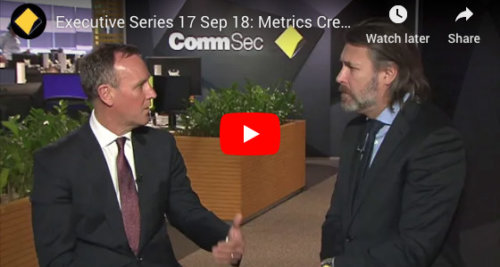Why investors in this asset class can ignore rate hikes and market risks
In this Livewire Income Series interview, Metrics Managing Partner Andrew Lockhart discusses how Metrics seeks to consistently offer investors low volatility and risk-adjusted returns, regardless of the economic environment.
“You’d be hard put to find any discussion of investments that doesn’t reference market risk events or the direction of interest rates. In fact, these have easily become your standard BBQ topic de jour in the past few years. After all, these have a significant impact on not just bank loans and mortgages, but also the traditional portfolio stalwarts of equities and bonds. It’s a critical concern for income investors of any age.
But ask Metrics Credit Partners’ Andrew Lockhart his thoughts on the market, and you’ll find he shrugs it off.
“We’re not really subject to market risk events and those sorts of things. We lend on what I believe are appropriate terms and conditions.
His focus is on the fundamentals of the deals he makes and assessing all known and potential risks that can come up. It means that macro events take second place to being confident in the quality of the loans he has made.
Now obviously, you can get an event risk that may come up, but for us as a lender, that risk really is a risk that is born by shareholders and equity,” he says.
Lockhart notes that lenders become more cautious and put more onerous conditions on their loans – but companies still need capital – so those market risk events can actually still be a positive for lenders who can tighten their risk controls to generate returns.
The asset class Lockhart is talking about? Private markets – a broad and often misunderstood asset class in which Metrics Credit Partners has more than a decade of experience in successful management.
One of the fastest-growing market segments
This area of the market, popular with institutional and high-net-worth investors, has only become more accessible to retail investors in recent years—and it has boomed.
You could credit it both to the characteristics of private markets and the broader environment, which have forced investors to think more critically about their portfolios.
“When investors are looking for defensive characteristics around fixed income, there’s been a situation in public bond markets where returns have been adversely impacted as a result of rising interest rates. There’s been more volatility that has impacted investor returns,” Lockhart says.
Private markets naturally look appealing in this environment.
“There are a lot of features that are attractive for investors: where you sit in the capital structure, the terms, the conditions, the covenants, the security are all designed to protect investor capital,” he says.
Rate rise? No problem
Then there’s the fact that the direction of interest rates scarcely matters when it comes to private markets. As Lockhart explains, this comes down to the fact that the majority of loans are subject to a floating rate, “which is a market-based rate”.
“Those floating rates just mean there’s no general lag in terms of when that income is paid to investors,” Lockhart says, pointing out that Metrics typically aim for shorter-dated exposures to reduce market risks and allow investors to be less exposed negatively to interest rate changes.
He describes the baseline used by lenders like Metrics as the Bank Bill Swap Rate (BBSW) and then a margin which can be set based on factors like risk profile, loan term, transaction size or the industry. In addition, there’s a fee income charged to the borrower.
“That whole combination of fee margins together with a floating base rate is really what drives the revenue that is generated for our lending activity and becomes the source of income for our investors,” says Lockhart.
“Interest rates have gone from 10 basis points with the RBA cash rate and are now at 4.35%. There’s an immediate flow through because the market pricing of the Bank Bill Swap Rate reflects market conditions and investors’ expectations around future interest rate movements,” he adds.
It’s something to think about when you consider the pain felt by many investors in long-duration fixed income investments as hikes and inflation have bitten into yields.
Understanding the capital structure
In this interview for Livewire’s Income Series, Lockhart also explores how the capital structure has been a benefit to private market investors in the current environment, and how managers can minimise risks and volatility through deal structures. He also discusses how Metrics is structuring its portfolios now and into the next 12-24 months.
Livewire Markets | 18 June 2024
Other News
Research Paper: Six Trends for Private Credit in 2026
Metrics Credit Partners has released its latest research paper, Six Trends for Private Credit in 2026, exploring the opportunities and challenges…
Metrics Innovate Reconciliation Action Plan
We are proud to share our second Reconciliation Action Plan (RAP), reaffirming our commitment to truth, healing and unity. We…
INSIGHTS
MCP Income Opportunities Trust (MOT) lists on ASX
Sydney, 29 April 2019: The Trust Company (RE Services) Limited (ABN 45 003 278 831) (Responsible Entity) is the responsible…
MCP Master Income Trust wins Lonsec Listed Fund Award
The award came a year after MXT was listed on the Australian Securities Exchange






